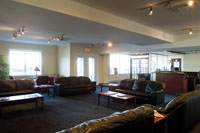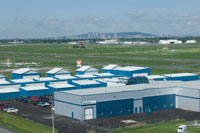
Features
Commercial
Growth Proposition on montreal’s shore
When Montrealers and visitors think of air travel to and from the city, they mostly think of the Trudeau International Airport in Dorval. Yet across the St. Lawrence River from Montreal Island, a few short kilometres but often an arduous commute away, reside some one million people in the South Shore and greater Monteregie region; most Canadian airports thrive on far smaller population bases.
May 13, 2010 By Carroll McCormick
When Montrealers and visitors think of air travel to and from the city, they mostly think of the Trudeau International Airport in Dorval. Yet across the St. Lawrence River from Montreal Island, a few short kilometres but often an arduous commute away, reside some one million people in the South Shore and greater Monteregie region; most Canadian airports thrive on far smaller population bases.
 |
|
| Pascan has logged 60,000 cycles and 50,000 hours without an incident. PHOTO: PASCAN
|
The South Shore does, however, have the Saint-Hubert Airport (formerly CFB Saint-Hubert). In 2004, Transport Canada divested its assets to the non-profit organization Développement Aéroport Saint-Hubert de Longueuil (DASH-L). It is said to be Canada’s busiest general aviation airport, with at least five fixed-wing flying schools, several charter operations and other private and industry tenants.
A 15-minute commute from downtown Montreal on a quiet day, it has a 7,840- by 150-foot main runway (24R/06L) with an Instrument Landing System on 24R and localizer back course on 06L. There are two shorter secondary runways.
More than one airline has eyed the airport for scheduled service, but the only one to successfully establish a long-term scheduled service there is Pascan Aviation, founded in 1999. On most days, Pascan has 60-70 scheduled departures to and from 13 destinations, including Rouyn/Noranda to the west, Wabush to the north and Îles-de-la-Madeleine way out in the Gulf of St. Lawrence. As well, Pascan offers charter flights to anywhere in North America.
Maintaining this pace requires 13 aircraft and about 80 employees, including 35 pilots and co-pilots, some 15 ground vehicles (plus cars and trucks stationed at other airports), 2,786 square metres of office and hangar space and 14,000 square metres of ramp space.
Plans to expand the fleet this year will have the airline serving about 220 city pairs every day, further realizing the dream of its founder and president, Serge Charron, to create a truly regional airline in Quebec. “We are the only such airline here,” says Charron. “We can say Air Creebec, but it serves the Cree population. Air Inuit serves the Inuit.” Charron does not regard Air Canada Jazz as a competitor. “I’d like to say I am complimentary to Jazz. We go to some of the same places, but we do it different ways. Jazz feeds Air Canada to major airports. Pascan is more of an inter-city carrier.”
In an upstairs boardroom, with a view of a full parking lot out of one window and a row of GA hangars from the other, Charron pokes at a map of eastern Canada and recites the names of regional carriers that have been relegated to Quebec aviation history. “Region Air, Air Shefferville, Air Alma, Air Satellite, Aviation Quebec-Labrador… These airlines were feeders to Inter Canadien, which closed in 1999, and Air Alliance, which became part of Air Canada. When Inter Canadien went bankrupt, it killed off these third level feeders, which had no reservation systems. As well, there was a silent rule for each to stay in its small region of Quebec. I wanted to cover the whole province independently,” Charron explains.
An Alberta-based aviation consultant once observed that airline founders are typically larger-than-life figures with turbo-charged egos and a powerful attraction to action and the limelight. Charron’s past, on the contrary, suggests his dream to launch a pan-Quebec airline was born more of a lifetime of flying, an intimate understanding of Quebec aviation – its successes, failures and shortcomings – and, one can assume, an astute business mind.
“Maybe I am an opportunist. I had a plan and a vision. I know the territory in Quebec. I know people everywhere,” Charron acknowledges. Thus equipped, Charron launched Pascan, with a single leased Pilatus PC-12, at the age of 49.
A pilot since he was just 16, he obtained his commercial licence at 18 and began working as bush pilot for Gagnon Air Service in 1970 at age 19, flying Cessnas, Beavers, and Otters. He flew the DC-3 for Les Ailes du Nord in Sept-Îles at 23 and logged many hours flying them on skis. In 1976, he began flying for the Quebec Air Service. The planes he piloted included the PBY Catalina flying boat and the Canadair CL-215 water bomber. He chauffeured premiers in the Hawker Siddeley HS-125, and the Fokker F27. He even flew the CL-415 from 1998-1999 for Italy’s Dipartimento Della Protezione Civile, and taught flying. He flew the Fire Boss AT-802 Water Scooper in Sudbury, Ont., in 2004.
Charron has about 10 aircraft types on his licence and has flown many more. He has logged about 16,000 hours in fixed-wing aircraft. He obtained his helicopter rating in early 2009 and by last December, had logged about 160 hours – the last few in a gorgeous blue and gold Robertson R44 he purchased. He still flies about 250 hours a year, mostly piloting scheduled flights for Pascan.
A new direction
In 1999, Charron left the Quebec Air Service to launch Pascan in Quebec City. Before long he had three leased PC-12s and a pretty good business that included scheduled, charter and cargo flights and a Canada Post contract to Îles-de-la-Madeleine. In 2003, he set up shop in a 10,000 sq.-ft. hangar, plus 5,000 sq. ft. of office space, on the east side of the Saint-Hubert Airport.
 |
|
| The Pascan waiting room hops with passengers on weekday mornings, and sits seconds from the parking PHOTOs: pascan
|
Then disaster struck in the form of “helpful” government meddling: In the wake of 9-11, the Quebec government, in its infinite wisdom, handed Air Canada $14 million to subsidize its regional operations. “The goal of the Quebec government, to be nice, was to protect the regions. Air Canada opens the world to the regions,” Charron says.
Charron met with Quebec’s then minister of transportation and demanded his share: the difference between what Pascan was earning before Air Canada got the $14 million and what Pascan was taking in after that move decimated his passenger traffic. He received nothing.
“That loan forced me to restructure,’ Charron says. “What saved me was my cargo contract and the diversified nature of my company, such as cargo, charter and medevac. I had to abandon the Canada Post contract and some routes. We focussed more on charter and gradually got our passengers back.”
To help recover from that flame-out, Charron took on Denis Charest in 2003 as a 50/50 partner.Charest is the president and chief executive officer of Boucherville, Que.-based Spectra Premium, a worldwide manufacturer of replacement car parts.
With leasing costs for the PC-12s soaring out of control, Charron returned them and bought four other PC-12s outright. In 2004, he sold one and bought four Beechcraft King Air B-100 twin turboprops. He bought three BAE Jetstream 32s in 2007, giving Pascan three aircraft types: the PC-12, King Air and Jetstream. He recently bought a Navajo Chieftain 350, dedicated to cargo runs between Saint-Hubert and Quebec City.
Expanding horizons
Pascan opened an FBO in 2005. “We have some customers who come here all the time,” Charron explained. “Many customers used to fly to Dorval and drive to the South Shore for business. When they discovered they could fly here, they enjoyed that.”
 |
|
| Montreal makes a beautiful backdrop to the nearby Saint-Hubert Airport. PHOTOs: pascan
|
Pascan completed a $3-million expansion in 2007 that increased the hangar and office space to 2,786 square metres. The waiting room, with comfy couches, TV and apron view, seems spacious in the afternoon, but gets rather intimate weekday mornings. Two discrete hangar areas (one the original building and one part of the expansion) are for fixed wing maintenance, where Pascan’s mechanics perform everything up to “C” checks on its own fleet, and do maintenance for outside customers.
Several helicopters are shoehorned into a third area, where Pascan does third-party chopper maintenance. Growing that business, however, will require space in a planned 2,972-square-metre expansion. “We have one dedicated helicopter mechanic and will build this business when we have more room,” Charron notes.
The plan, once the next expansion happens, is to convert the original hangar, with its big skylight, into a spacious passenger terminal, complete with baggage check, baggage belt and other amenities.
The upcoming fleet expansion (Charron wants to buy seven Jetstream 32s this year, and he is also looking for 40-seat passenger aircraft) and the anticipated terminal expansion will push the airline’s stake in the airport well beyond the $20 million or so it has already invested. To protect his stake, Charron has a sweet insurance policy up his sleeve: “Pascan has exclusivity at Saint-Hubert for the routes it has now,” he explains. “No one else can come into this airport and launch service to the same towns I fly to.”
As to whether this is a usual sort of arrangement, Charron is frank: “When someone comes to this airport and spends several million dollars…”
| People Powered Pascan Aviation is unusual among operators flying aircraft the size of the PC-12 in that it rewards its co-pilots with a salary and not only their flight hours, says founder and CEO Serge Charron. “From the beginning I paid my co-pilots,” he says. “I had to compete with other carriers who do not. I did not want to start a company on the back of my people. I wanted Pascan to be safe and the pilots to be well trained. I wanted a safe, pleasant company to work for.” It must certainly be inspiring to work for a boss who encourages independent thinking. “I give my employees a lot of rope,” Charron says. Events like the 10th anniversary celebration last summer, which opened with an F-18 fly by, and the Christmas party last December, are also good for company spirit: Pascan paid the tab to fly all the employees into Saint-Hubert from all its destination airports for the party and they stayed the weekend at Hôtel Brossard, owned by Pascan’s co-owner Denis Charest. “What is the success of the company? It is the spirit of the employees,” Charron says. “They are doing things with the same heart as if they were doing them for themselves. The success is not for me. It is for my people.” |